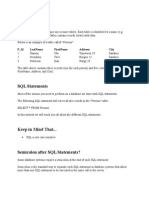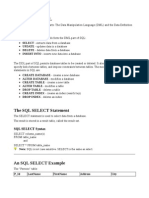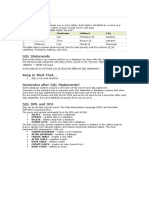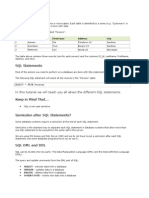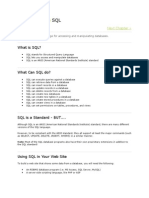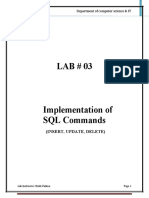Lab Module 4 - BASIC DML Commands For MySQL
Uploaded by
RavenfoxrodLab Module 4 - BASIC DML Commands For MySQL
Uploaded by
RavenfoxrodDatabase Management System (DBMS 223)
Laurence G. De Jesus
1 |LAB MODULE 4: B A S I C D M L C o m m a n d s f o r M y S Q L
DHVTSU-CCS
Department of Information Technology
LAB MODULE 4:i BASIC DML Commands for MySQL
SQL SELECT Statement
The SELECT statement is used to select data from a database.
The result is stored in a result table, called the result-set.
SQL SELECT Syntax
SELECT column_name(s)
FROM table_name;
And
SELECT * FROM table_name;
Note: SQL is not case sensitive. SELECT is the same as select.
An SQL SELECT Example
The "Persons" table:
P_Id LastName FirstName Address City
1 Hansen Ola Timoteivn 10 Sandnes
2 Svendson Tove Borgvn 23 Sandnes
3 Pettersen Kari Storgt 20 Stavanger
Now we want to select the content of the columns named "LastName" and
"FirstName" from the table above.
We use the following SELECT statement:
SELECT LastName,FirstName FROM Persons;
The result-set will look like this:
LastName FirstName
Hansen Ola
Svendson Tove
Pettersen Kari
SELECT * Example
Now we want to select all the columns from the "Persons" table.
We use the following SELECT statement:
SELECT * FROM Persons;
Tip: The asterisk (*) is a quick way of selecting all columns!
The result-set will look like this:
P_Id LastName FirstName Address City
1 Hansen Ola Timoteivn 10 Sandnes
2 Svendson Tove Borgvn 23 Sandnes
3 Pettersen Kari Storgt 20 Stavanger
Database Management System (DBMS 223)
Laurence G. De Jesus
2 |LAB MODULE 4: B A S I C D M L C o m m a n d s f o r M y S Q L
DHVTSU-CCS
Department of Information Technology
The SQL SELECT DISTINCT Statement
In a table, some of the columns may contain duplicate values. This is not a
problem, however, sometimes you will want to list only the different (distinct)
values in a table.
The DISTINCT keyword can be used to return only distinct (different) values.
SQL SELECT DISTINCT Syntax
SELECT DISTINCT column_name
FROM table_name;
SELECT DISTINCT Example
The "Persons" table:
P_Id LastName FirstName Address City
1 Hansen Ola Timoteivn 10 Sandnes
2 Svendson Tove Borgvn 23 Sandnes
3 Pettersen Kari Storgt 20 Stavanger
Now we want to select only the distinct values from the column named "City"
from the table above.
We use the following SELECT statement:
SELECT DISTINCT City FROM Persons;
The result-set will look like this:
City
Sandnes
Stavanger
The WHERE Clause
The WHERE clause is used to extract only those records that fulfill a specified
criterion.
SQL WHERE Syntax
SELECT column_name(s)
FROM table_name
WHERE column_name operator value;
WHERE Clause Example
The "Persons" table:
P_Id LastName FirstName Address City
1 Hansen Ola Timoteivn 10 Sandnes
2 Svendson Tove Borgvn 23 Sandnes
3 Pettersen Kari Storgt 20 Stavanger
Now we want to select only the persons living in the city "Sandnes" from the
table above.
Database Management System (DBMS 223)
Laurence G. De Jesus
3 |LAB MODULE 4: B A S I C D M L C o m m a n d s f o r M y S Q L
DHVTSU-CCS
Department of Information Technology
We use the following SELECT statement:
SELECT * FROM Persons
WHERE City='Sandnes';
The result-set will look like this:
P_Id LastName FirstName Address City
1 Hansen Ola Timoteivn 10 Sandnes
2 Svendson Tove Borgvn 23 Sandnes
Quotes around Text Fields
SQL uses single quotes around text values (most database systems will also
accept double quotes).
Although, numeric values should not be enclosed in quotes.
For text values:
THIS IS CORRECT:
SELECT * FROM Persons WHERE FirstName='Tove';
THIS IS WRONG:
SELECT * FROM Persons WHERE FirstName=Tove;
For numeric values:
THIS IS CORRECT:
SELECT * FROM Persons WHERE Year=1965;
THIS IS WRONG:
SELECT * FROM Persons WHERE Year='1965';
For date values:
THIS IS CORRECT:
SELECT * FROM persons WHERE testdate='2013-08-17';
THIS IS WRONG:
SELECT * FROM persons WHERE testdate=2013-08-17;
Database Management System (DBMS 223)
Laurence G. De Jesus
4 |LAB MODULE 4: B A S I C D M L C o m m a n d s f o r M y S Q L
DHVTSU-CCS
Department of Information Technology
Operators Allowed in the WHERE Clause
With the WHERE clause, the following operators can be used:
Operator Description
= Equal
<> Not equal
> Greater than
< Less than
>= Greater than or equal
<= Less than or equal
BETWEEN Between an inclusive range
LIKE Search for a pattern
IN If you know the exact value you want to return for at least one of the
columns
Note: In some versions of SQL the <> operator may be written as !=
The SQL BETWEEN Operator
The BETWEEN operator selects a range of data between two values. The values
can be numbers, text, or dates.
SQL BETWEEN Syntax
SELECT column_name(s)
FROM table_name
WHERE column_name
BETWEEN value1 AND value2;
The "Persons" table:
P_Id LastName FirstName Address City
1 Hansen Ola Timoteivn 10 Sandnes
2 Svendson Tove Borgvn 23 Sandnes
3 Pettersen Kari Storgt 20 Stavanger
Now we want to select the persons with a last name alphabetically between
"Hansen" and "Pettersen" from the table above.
We use the following SELECT statement:
SELECT * FROM Persons
WHERE LastName
BETWEEN 'Hansen' AND 'Pettersen';
The result-set will look like this:
P_Id LastName FirstName Address City
1 Hansen Ola Timoteivn 10 Sandnes
3 Pettersen Kari Storgt 20 Stavanger
Note: The BETWEEN operator is treated differently in different databases!
In some databases, persons with the LastName of "Hansen" or "Pettersen" will
not be listed, because the BETWEEN operator only selects fields that are between
and excluding the test values.
Database Management System (DBMS 223)
Laurence G. De Jesus
5 |LAB MODULE 4: B A S I C D M L C o m m a n d s f o r M y S Q L
DHVTSU-CCS
Department of Information Technology
In other databases, persons with the LastName of "Hansen" or "Pettersen" will be
listed, because the BETWEEN operator selects fields that are between and
including the test values.
And in other databases, persons with the LastName of "Hansen" will be listed, but
"Pettersen" will not be listed (like the example above), because the
BETWEEN operator selects fields between the test values, including the first test
value and excluding the last test value.
Therefore: Check how your database treats the BETWEEN operator.
Example 2
To display the persons outside the range in the previous example, use NOT
BETWEEN:
SELECT * FROM Persons
WHERE LastName
NOT BETWEEN 'Hansen' AND 'Pettersen';
The result-set will look like this:
P_Id LastName FirstName Address City
2 Svendson Tove Borgvn 23 Sandnes
The SQL LIKE Operator
The LIKE operator is used in a WHERE clause to search for a specified pattern in
a column.
SQL LIKE Syntax
SELECT column_name(s)
FROM table_name
WHERE column_name LIKE pattern;
LIKE Operator Example
The "Persons" table:
P_Id LastName FirstName Address City
1 Hansen Ola Timoteivn 10 Sandnes
2 Svendson Tove Borgvn 23 Sandnes
3 Pettersen Kari Storgt 20 Stavanger
Now we want to select the persons living in a city that starts with "s" from the
table above.
We use the following SELECT statement:
SELECT * FROM Persons
WHERE City LIKE 's%';
The "%" sign can be used to define wildcards (missing letters in the pattern) both
before and after the pattern.
Database Management System (DBMS 223)
Laurence G. De Jesus
6 |LAB MODULE 4: B A S I C D M L C o m m a n d s f o r M y S Q L
DHVTSU-CCS
Department of Information Technology
The result-set will look like this:
P_Id LastName FirstName Address City
1 Hansen Ola Timoteivn 10 Sandnes
2 Svendson Tove Borgvn 23 Sandnes
3 Pettersen Kari Storgt 20 Stavanger
Next, we want to select the persons living in a city that ends with an "s" from the
"Persons" table.
We use the following SELECT statement:
SELECT * FROM Persons
WHERE City LIKE '%s';
The result-set will look like this:
P_Id LastName FirstName Address City
1 Hansen Ola Timoteivn 10 Sandnes
2 Svendson Tove Borgvn 23 Sandnes
Next, we want to select the persons living in a city that contains the pattern "tav"
from the "Persons" table.
We use the following SELECT statement:
SELECT * FROM Persons
WHERE City LIKE '%tav%';
The result-set will look like this:
P_Id LastName FirstName Address City
3 Pettersen Kari Storgt 20 Stavanger
It is also possible to select the persons living in a city that does NOT contain the
pattern "tav" from the "Persons" table, by using the NOT keyword.
We use the following SELECT statement:
SELECT * FROM Persons
WHERE City NOT LIKE '%tav%';
The result-set will look like this:
P_Id LastName FirstName Address City
1 Hansen Ola Timoteivn 10 Sandnes
2 Svendson Tove Borgvn 23 Sandnes
SQL Wildcards
SQL wildcards can substitute for one or more characters when searching for data
in a database.
SQL wildcards must be used with the SQL LIKE operator.
Database Management System (DBMS 223)
Laurence G. De Jesus
7 |LAB MODULE 4: B A S I C D M L C o m m a n d s f o r M y S Q L
DHVTSU-CCS
Department of Information Technology
With SQL, the following wildcards can be used:
Wildcard Description
% A substitute for zero or more characters
_ A substitute for exactly one character
Using the _ Wildcard
Now we want to select the persons with a first name that starts with any
character, followed by "la" from the "Persons" table.
We use the following SELECT statement:
SELECT * FROM Persons
WHERE FirstName LIKE '_la';
The result-set will look like this:
P_Id LastName FirstName Address City
1 Hansen Ola Timoteivn 10 Sandnes
Next, we want to select the persons with a last name that starts with "S",
followed by any character, followed by "end", followed by any character, followed
by "on" from the "Persons" table.
We use the following SELECT statement:
SELECT * FROM Persons
WHERE LastName LIKE 'S_end_on';
The result-set will look like this:
P_Id LastName FirstName Address City
2 Svendson Tove Borgvn 23 Sandnes
SQL IN Operator
The IN operator allows you to specify multiple values in a WHERE clause.
SQL IN Syntax
SELECT column_name(s)
FROM table_name
WHERE column_name IN (value1,value2,...);
IN Operator Example
We want to select the persons with a last name equal to "Hansen" or "Pettersen"
from the table above.
We use the following SELECT statement:
SELECT * FROM Persons
WHERE LastName IN ('Hansen','Pettersen');
Database Management System (DBMS 223)
Laurence G. De Jesus
8 |LAB MODULE 4: B A S I C D M L C o m m a n d s f o r M y S Q L
DHVTSU-CCS
Department of Information Technology
The result-set will look like this:
P_Id LastName FirstName Address City
1 Hansen Ola Timoteivn 10 Sandnes
3 Pettersen Kari Storgt 20 Stavanger
IS NULL Operator
This operator checks for a null attribute value.
SELECT column_name(s)
FROM table_name
WHERE column_name IS NULL;
SQL AND & OR Operators
The AND operator displays a record if both the first condition and the second
condition is true.
The OR operator displays a record if either the first condition or the second
condition is true.
AND Operator Example
We want to select only the persons with the first name equal to "Tove" AND the
last name equal to "Svendson":
We use the following SELECT statement:
SELECT * FROM Persons
WHERE FirstName='Tove'
AND LastName='Svendson';
The result-set will look like this:
P_Id LastName FirstName Address City
2 Svendson Tove Borgvn 23 Sandnes
OR Operator Example
Now we want to select only the persons with the first name equal to "Tove" OR
the first name equal to "Ola":
We use the following SELECT statement:
SELECT * FROM Persons
WHERE FirstName='Tove'
OR FirstName='Ola';
The result-set will look like this:
P_Id LastName FirstName Address City
1 Hansen Ola Timoteivn 10 Sandnes
2 Svendson Tove Borgvn 23 Sandnes
Database Management System (DBMS 223)
Laurence G. De Jesus
9 |LAB MODULE 4: B A S I C D M L C o m m a n d s f o r M y S Q L
DHVTSU-CCS
Department of Information Technology
Combining AND & OR
You can also combine AND and OR (use parenthesis to form complex
expressions).
Now we want to select only the persons with the last name equal to "Svendson"
AND the first name equal to "Tove" OR to "Ola":
We use the following SELECT statement:
SELECT * FROM Persons WHERE
LastName='Svendson'
AND (FirstName='Tove' OR FirstName='Ola');
The result-set will look like this:
P_Id LastName FirstName Address City
2 Svendson Tove Borgvn 23 Sandnes
SQL AND & OR Operators
The ORDER BY keyword is used to sort the result-set by a specified column.
The ORDER BY keyword sort the records in ascending order by default.
If you want to sort the records in a descending order, you can use the DESC
keyword.
SQL ORDER BY Syntax
SELECT column_name(s)
FROM table_name
ORDER BY column_name(s) ASC|DESC;
ORDER BY Example
The "Persons" table:
P_Id LastName FirstName Address City
1 Hansen Ola Timoteivn 10 Sandnes
2 Svendson Tove Borgvn 23 Sandnes
3 Pettersen Kari Storgt 20 Stavanger
Now we want to select all the persons from the table above, however, we want to
sort the persons by their last name.
We use the following SELECT statement:
SELECT * FROM Persons
ORDER BY LastName;
The result-set will look like this:
P_Id LastName FirstName Address City
1 Hansen
Ola Timoteivn 10 Sandnes
3 Pettersen
Kari Storgt 20 Stavanger
2 Svendson
Tove Borgvn 23 Sandnes
Database Management System (DBMS 223)
Laurence G. De Jesus
10 |LAB MODULE 4: B A S I C D M L C o m m a n d s f o r M y S Q L
DHVTSU-CCS
Department of Information Technology
ORDER BY DESC Example
Now we want to select all the persons from the table above, however, we want to
sort the persons descending by their last name.
We use the following SELECT statement:
SELECT * FROM Persons
ORDER BY LastName DESC;
The result-set will look like this:
P_Id LastName FirstName Address City
2 Svendson Tove Borgvn 23 Sandnes
3 Pettersen Kari Storgt 20 Stavanger
1 Hansen Ola Timoteivn 10 Sandnes
SQL INSERT INTO Statement
The INSERT INTO statement is used to insert a new row in a table.
SQL INSERT INTO Syntax
It is possible to write the INSERT INTO statement in two forms.
The first form doesn't specify the column names where the data will be inserted,
only their values:
INSERT INTO table_name
VALUES (value1, value2, value3,...);
The second form specifies both the column names and the values to be inserted:
INSERT INTO table_name (column1, column2, column3,...)
VALUES (value1, value2, value3,...);
SQL INSERT INTO Example
We have the following "Persons" table:
P_Id LastName FirstName Address City
1 Hansen Ola Timoteivn 10 Sandnes
2 Svendson Tove Borgvn 23 Sandnes
3 Pettersen Kari Storgt 20 Stavanger
Now we want to insert a new row in the "Persons" table.
We use the following SQL statement:
INSERT INTO Persons
VALUES (4,'Nilsen', 'Johan', 'Bakken 2', 'Stavanger');
The "Persons" table will now look like this:
P_Id
LastName FirstName Address City
1
Hansen Ola Timoteivn 10 Sandnes
2
Svendson Tove Borgvn 23 Sandnes
3
Pettersen Kari Storgt 20 Stavanger
4
Nilsen Johan Bakken 2 Stavanger
Database Management System (DBMS 223)
Laurence G. De Jesus
11 |LAB MODULE 4: B A S I C D M L C o m m a n d s f o r M y S Q L
DHVTSU-CCS
Department of Information Technology
Insert Data Only in Specified Columns
It is also possible to only add data in specific columns.
The following SQL statement will add a new row, but only add data in the "P_Id",
"LastName" and the "FirstName" columns:
INSERT INTO Persons (P_Id, LastName, FirstName)
VALUES (5, 'Tjessem', 'Jakob');
The "Persons" table will now look like this:
P_Id LastName FirstName Address City
1 Hansen Ola Timoteivn 10 Sandnes
2 Svendson Tove Borgvn 23 Sandnes
3 Pettersen Kari Storgt 20 Stavanger
4 Nilsen Johan Bakken 2 Stavanger
5 Tjessem Jakob
SQL UPDATE Statement
The UPDATE statement is used to update existing records in a table.
SQL UPDATE Syntax
UPDATE table_name
SET column1=value, column2=value2,...
WHERE some_column=some_value;
Note: Notice the WHERE clause in the UPDATE syntax. The WHERE clause
specifies which record or records that should be updated. If you omit the WHERE
clause, all records will be updated!
SQL UPDATE Example
The "Persons" table:
P_Id
LastName FirstName Address City
1
Hansen Ola Timoteivn 10 Sandnes
2
Svendson Tove Borgvn 23 Sandnes
3
Pettersen Kari Storgt 20 Stavanger
4
Nilsen Johan Bakken 2 Stavanger
5
Tjessem Jakob
Now we want to update the person "Tjessem, Jakob" in the "Persons" table.
We use the following SQL statement:
UPDATE Persons
SET Address='Nissestien 67', City='Sandnes'
WHERE LastName='Tjessem' AND FirstName='Jakob';
The "Persons" table will now look like this:
P_Id
LastName FirstName Address City
1
Hansen Ola Timoteivn 10 Sandnes
2
Svendson Tove Borgvn 23 Sandnes
3
Pettersen Kari Storgt 20 Stavanger
4
Nilsen Johan Bakken 2 Stavanger
5
Tjessem Jakob Nissestien 67 Sandnes
Database Management System (DBMS 223)
Laurence G. De Jesus
12 |LAB MODULE 4: B A S I C D M L C o m m a n d s f o r M y S Q L
DHVTSU-CCS
Department of Information Technology
SQL UPDATE Warning
Be careful when updating records. If we had omitted the WHERE clause in the
example above, like this:
UPDATE Persons
SET Address='Nissestien 67', City='Sandnes';
The "Persons" table would have looked like this:
P_Id
LastName FirstName Address City
1 Hansen Ola Nissestien 67 Sandnes
2 Svendson Tove Nissestien 67 Sandnes
3 Pettersen Kari Nissestien 67 Sandnes
4 Nilsen Johan Nissestien 67 Sandnes
5 Tjessem Jakob Nissestien 67 Sandnes
SQL DELETE Statement
The DELETE statement is used to delete rows in a table.
SQL DELETE Syntax
DELETE FROM table_name
WHERE some_column=some_value;
Note: Notice the WHERE clause in the DELETE syntax. The WHERE clause
specifies which record or records that should be deleted. If you omit the WHERE
clause, all records will be deleted!
SQL DELETE Example
The "Persons" table:
P_Id
LastName FirstName Address City
1
Hansen Ola Timoteivn 10 Sandnes
2
Svendson Tove Borgvn 23 Sandnes
3
Pettersen Kari Storgt 20 Stavanger
4
Nilsen Johan Bakken 2 Stavanger
5
Tjessem Jakob Nissestien 67 Sandnes
Now we want to delete the person "Tjessem, Jakob" in the "Persons" table.
We use the following SQL statement:
DELETE FROM Persons
WHERE LastName='Tjessem' AND FirstName='Jakob';
The "Persons" table will now look like this:
P_Id
LastName FirstName Address City
1
Hansen Ola Timoteivn 10 Sandnes
2
Svendson Tove Borgvn 23 Sandnes
3
Pettersen Kari Storgt 20 Stavanger
4
Nilsen Johan Bakken 2 Stavanger
Delete All Rows
It is possible to delete all rows in a table without deleting the table. This means
that the table structure, attributes, and indexes will be intact:
Database Management System (DBMS 223)
Laurence G. De Jesus
13 |LAB MODULE 4: B A S I C D M L C o m m a n d s f o r M y S Q L
DHVTSU-CCS
Department of Information Technology
DELETE FROM table_name;
or
DELETE * FROM table_name;
Note: Be very careful when deleting records. You cannot undo this statement!
TRUNCATE Statement
Deletes all rows within the table and resets the primary key of that table which
has an auto_increment attribute back to Zero (0).
TRUNCATE TABLE table_name;
You might also like
- Lab # 05 Implementation of SQL Wildcards & OperatorsNo ratings yetLab # 05 Implementation of SQL Wildcards & Operators11 pages
- Database Tables: P - Id Lastname Firstname Address CityNo ratings yetDatabase Tables: P - Id Lastname Firstname Address City19 pages
- ST, Marry University Faculty of Informatics Department of Computer ScienceNo ratings yetST, Marry University Faculty of Informatics Department of Computer Science42 pages
- SQL Is A Standard Language For Accessing and Manipulating DatabasesNo ratings yetSQL Is A Standard Language For Accessing and Manipulating Databases13 pages
- SQL Is A Standard Language For Accessing and Manipulating Databases100% (1)SQL Is A Standard Language For Accessing and Manipulating Databases190 pages
- SQL Is A Standard Language For Accessing and Manipulating DatabasesNo ratings yetSQL Is A Standard Language For Accessing and Manipulating Databases19 pages
- What Is SQL?: SQL Is A Standard Language For Accessing and Manipulating DatabasesNo ratings yetWhat Is SQL?: SQL Is A Standard Language For Accessing and Manipulating Databases15 pages
- Dbms Lab # 4: SQL Wildcards & OperatorsNo ratings yetDbms Lab # 4: SQL Wildcards & Operators10 pages
- Lab # 03 Implementation of SQL CommandsNo ratings yetLab # 03 Implementation of SQL Commands19 pages
- Using Advanced Structured Query LanguageNo ratings yetUsing Advanced Structured Query Language59 pages
- Advantages of Dynamic Routing Over Static RoutingNo ratings yetAdvantages of Dynamic Routing Over Static Routing5 pages
- Object Oriented Programming in C 4th Edition1No ratings yetObject Oriented Programming in C 4th Edition19 pages
- Functional Programming For The Object Oriented Programmer100% (4)Functional Programming For The Object Oriented Programmer51 pages
- PKI Deployment - Business Issues: An Oasis White PaperNo ratings yetPKI Deployment - Business Issues: An Oasis White Paper15 pages
- Step7 s7 Safety Matrix Configuration Manual en US en-US PDFNo ratings yetStep7 s7 Safety Matrix Configuration Manual en US en-US PDF204 pages
- Attribute Management White Paper 11-5-10 PlusNo ratings yetAttribute Management White Paper 11-5-10 Plus42 pages
- ITT Training Most Important 1500 Questions PDFNo ratings yetITT Training Most Important 1500 Questions PDF202 pages
- Ebook Db2 Performance Handbook All en 1006No ratings yetEbook Db2 Performance Handbook All en 1006170 pages
- Neural Signal Processing: ELEC 548 - Fall 2015 Tuesday/Thursday 09:25AM - 10:40AM BRC 284No ratings yetNeural Signal Processing: ELEC 548 - Fall 2015 Tuesday/Thursday 09:25AM - 10:40AM BRC 28431 pages
- Overview of Software Defect Prediction Using Machine Learning AlgorithmsNo ratings yetOverview of Software Defect Prediction Using Machine Learning Algorithms12 pages
- The Ring Programming Language Version 1.4 Book - Part 8 of 30No ratings yetThe Ring Programming Language Version 1.4 Book - Part 8 of 3030 pages
- Networked Programs: Python For EverybodyNo ratings yetNetworked Programs: Python For Everybody62 pages
- 1z0 434 Oraclesoasuite12cessentials Blogspot Pe 2015-12-1z0No ratings yet1z0 434 Oraclesoasuite12cessentials Blogspot Pe 2015-12-1z030 pages








